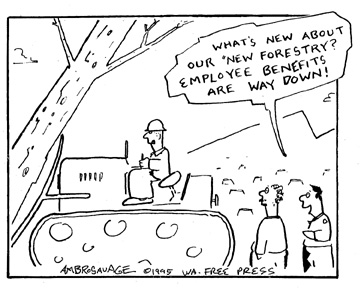
 FIRST WORD
FIRST WORD
IDEAS THAT
CUT THROUGH
THE BS
NEW! IMPROVED FORESTRY!
Don't believe the hype. There are better ways to log a forest.
By Mike Blain
The Free Press
The most overused and meaningless word in marketing is "new." Just slap that adjective in front of the name of some tired old product that isn't selling too well and you have a fresh advertising campaign. You've probably seen them all:
"NEW AND IMPROVED!"
"NEW 24-oz. BAG!"
"NEW E-Z GLIDE APPLICATOR!"
"NEW FLAVOR CRYSTALS!"
"NEW! NOW EVEN SOFTER!"
It doesn't matter if the product is really no different from before; just alter the container a little and put a bright, neon orange "NEW!" on the package and people will be convinced something has changed for the better and start opening their wallets once again.
More often than not, the only thing that's really new about the product is the fact that it now has a "new" in front of its name.
This advertising approach works especially well if the old product has somehow been tainted in the public's eye. Are marketing surveys revealing that consumers no longer have a positive reaction to your product's name? Did you end up on the wrong side of a nasty lawsuit over the safety of your product? No problem. Just distance yourself from the old product by saying that, yes, it wan't perfect, but this "new" version is great. No need to waste money actually fixing it - just change the packaging.
It would appear that the timber industry has learned a few lessons from the mass-marketers. After being dragged kicking and screaming over the last five years into changing some of its most damaging forestry practices, the industry has now adopted some of the buzzwords of its critics.
"New forestry" has officially been adopted by Weyerhaueser, Plum Creek Timber Co. and many other large industrial timber operations.
But what exactly is "new" about new forestry? Clear-cutting itself is new. It is a method of forestry that didn't come into widespread use until the 1960s. Is new forestry any different from the sham of "sustainable" clear-cutting that has been practiced over the last 30 years, or is it just the same old thing packaged differently?
New forestry is a term that is increasingly hard to pin down. As a practice, it varies considerably from place to place and company to company. Essentially, it encompass an approach to forestry that takes into account the effects of logging on an entire ecosystem. A primary goal is to mitigate the negative effects of clear-cutting - such as the destruction of fish and wildlife habitat and watershed degradation - without significantly reducing timber production.
Methods for accomplishing this include leaving streamside buffers of uncut trees, leaving a certain number of trees standing per acre, and reducing the size of clear-cuts.
Another goal is to reduce the "ugly" nature of clear-cuts by not putting them near highways and by feathering the edges of the cuts to follow topographic lines so that they aren't so visibly jarring.
Granted, many of these these things are new. The timber industry never used to talk seriously about protecting salmon spawning grounds or leaving "wildlife trees." Now it does.

Unfortunately, much of new forestry smacks of new packaging. What has really changed? Instead of cutting down 100 percent of the trees in a given area, they now cut only 95 percent.
Reducing the "visual impact" of clear-cuts, however appealing that may be, is obviously an effort at finding a new way to market clear-cutting so that it is more palatable to the public. It is certainly not a fundamental change in the way forests are logged.
And for these largely cosmetic changes, the timber industry pats itself on the back and asks the public to believe that everything is different from those days not so long ago when they cut down every tree in sight.
The truth is that new forestry, as practiced by large commerical timber operations, is really just modified clear-cutting. They go in, they cut down most of the trees, and then they replant. The forest is gone. The primary thing that is new is the presentation
This isn't to say that things have not changed for the better. They have. But don't believe the hype. This brand of new and improved forestry is not the answer to meeting society's demand for wood while protecting wildlife habitat.
Fortunately, there are some answers. There are other ways to log, methods of forestry which can produce just as much timber as clear-cutting over the long-term, but which don't destroy the forest in the process.
Fort Lewis Army base, just south of Tacoma, provides a glimpse at the type of productive, forest-enhancing logging that is possible when the political and economic pressure to clear-cut is removed.
Ft. Lewis' has the luxury of operating outside these political and economic constraints because of the Army's desire for a closed-canopy forest for training exercises - a condition that won't be duplicated on Forest Service or Weyerhaueser land.
The base can still offer many lessons for foresters throughout the region. The Forest Service, for example, could easily start applying some of the selective logging methods practiced at Fort Lewis to its own land, even if it were simply to experiment.
Truly sustainable logging requires an approach to forestry that does not worship quarterly profits or annual cut levels set by Senators in Washington, D.C. It emphasizes the long-term health of the forest just as much as timber production. Ft. Lewis illustrates that it is possible to run a succesful logging operation in the Northwest without destroying the forest.
[Home]
[This Issue's Directory]
[WFP Index]
[WFP Back Issues]
[E-Mail WFP]
Contents on this page were published in the December/January, 1996 edition of the Washington Free
Press.
WFP, 1463 E. Republican #178, Seattle, WA -USA, 98112. -- WAfreepress@gmail.com
Copyright © 1996 WFP Collective, Inc.






